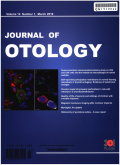- 钛学术文献服务平台 \
- 学术期刊 \
- 医药卫生期刊 \
- 五官科学期刊 \
- 中华耳科学杂志(英文版)期刊 \
Malleostapedotomy for otosclerosis, our experience of nitinol piston on twelve patients
Malleostapedotomy for otosclerosis, our experience of nitinol piston on twelve patients
基本信息来源于合作网站,原文需代理用户跳转至来源网站获取
摘要:
Objective: Malleostapedotomy allows to completely by-pass the incus in otosclerosis surgery. Recently its use has been rivaled by hydroxyapatite cement for cases of mild and moderate necrosis of the incus. However, it remains gold standard for cases of extensive necrosis, incus dislocation, or epitympanic fixation. Modern heat-crimping pistons make surgery easier and safer. This study focuses on our expe-rience with this technique.Methods: Retrospective analysis of patient's files and pre- and post-operative audiograms, for cases of surgically treated otosclerosis with malleostapedotomy. Results: Twelve patients underwent malleostapedotomy for otosclerosis between 2011 and 2019. Amongst them there were 10 revision surgeries and 2 primary cases. 75% had incus long-process ne-crosis, 17%had epitympanic fixation and one had a history of incus transposition. Nine patients (75%) had closure of air-bone gap (ABG) of<10 dB (p<0.001) and 11 (92%) had a threshold of 20 dB (p<0.001). Mean pre-operative ABG was 31 dB (15 dB-55 dB), and mean post-operative ABG was 7 dB (0 dB-21 dB;p<0.001). There was no sensorineural hearing loss nor any other post-operative complication. Conclusions: Malleostapedotomy is a safe and reliable technique, allowing an ABG closure comparable to conventional incus to vestibule prosthesis. It remains the preferred technique whenever the incus cannot be used.

推荐文章
Nitinol60形状记忆合金高温变形特性研究
Nitinol 60形状记忆合金
加工图
高温变形特性
A2/O系统PHB和OUR监测及其分析研究
A2/O
聚羟基丁酸酯
呼吸好氧速率
聚磷菌
Analysis on influencing factors of patients experience in community health centers of Shenzhen,China
Piston-Cylinder高温高压实验装置及在壳幔动力学研究中的应用
Piston-Cylinder
高温高压实验
壳幔动力学
内容分析
关键词云
关键词热度
相关文献总数
(/次)
(/年)
文献信息
| 篇名 | Malleostapedotomy for otosclerosis, our experience of nitinol piston on twelve patients | ||
| 来源期刊 | 中华耳科学杂志(英文版) | 学科 | |
| 关键词 | |||
| 年,卷(期) | 2020,(4) | 所属期刊栏目 | Research Articles |
| 研究方向 | 页码范围 | 129-132 | |
| 页数 | 4页 | 分类号 | |
| 字数 | 语种 | 英文 | |
| DOI | |||
五维指标
引文网络
引文网络
二级参考文献 (0)
共引文献 (0)
参考文献 (15)
节点文献
引证文献 (0)
同被引文献 (0)
二级引证文献 (0)
1950(1)
- 参考文献(1)
- 二级参考文献(0)
1995(1)
- 参考文献(1)
- 二级参考文献(0)
2003(1)
- 参考文献(1)
- 二级参考文献(0)
2007(1)
- 参考文献(1)
- 二级参考文献(0)
2011(2)
- 参考文献(2)
- 二级参考文献(0)
2012(1)
- 参考文献(1)
- 二级参考文献(0)
2014(2)
- 参考文献(2)
- 二级参考文献(0)
2016(1)
- 参考文献(1)
- 二级参考文献(0)
2017(1)
- 参考文献(1)
- 二级参考文献(0)
2018(2)
- 参考文献(2)
- 二级参考文献(0)
2019(2)
- 参考文献(2)
- 二级参考文献(0)
2020(0)
- 参考文献(0)
- 二级参考文献(0)
- 引证文献(0)
- 二级引证文献(0)
引文网络交叉学科
相关学者/机构
期刊影响力
中华耳科学杂志(英文版)
主办单位:
解放军总医院耳鼻咽喉科研究所
出版周期:
季刊
ISSN:
1672-2930
CN:
11-4883/R
开本:
出版地:
北京市复兴路28号
邮发代号:
创刊时间:
语种:
eng
出版文献量(篇)
450
总下载数(次)
0
总被引数(次)
399
期刊文献
相关文献
推荐文献
- 期刊分类
- 期刊(年)
- 期刊(期)
- 期刊推荐

 免费查重
免费查重










